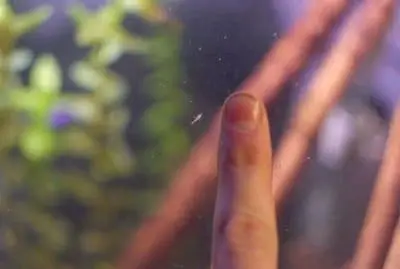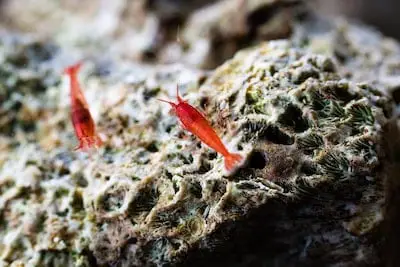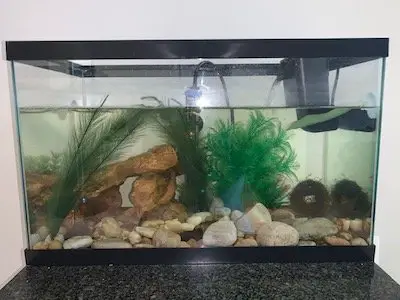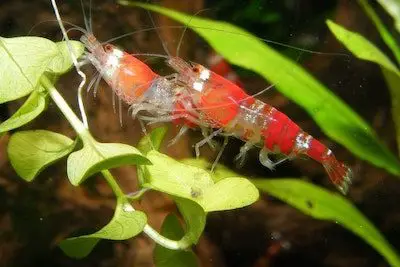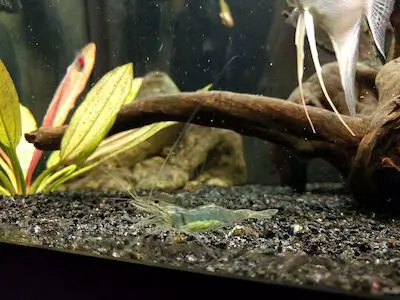Shrimp Breeding Tank Setup: Everything You Need to Know
A shrimp breeding tank setup takes a little more thought and planning than simply buying shrimp and a tank and hoping for the best. However, it may not be as daunting as you probably picture in your mind.
When planning your shrimp breeding tank setup, you should consider certain factors, such as filtration, water parameters, diet, and hiding spots. Surprisingly enough, tanks aren’t as big a deal as some new shrimp breeders may think. A bigger one may be visually pleasing, but you can also make a two-gallon tank work.
Shrimp are incredibly delicate aquatic creatures, though, so you’re going to need some specifics before you break out that credit card. Read on to find out exactly what you need to include in your tank setup if you’re planning on breeding shrimp.
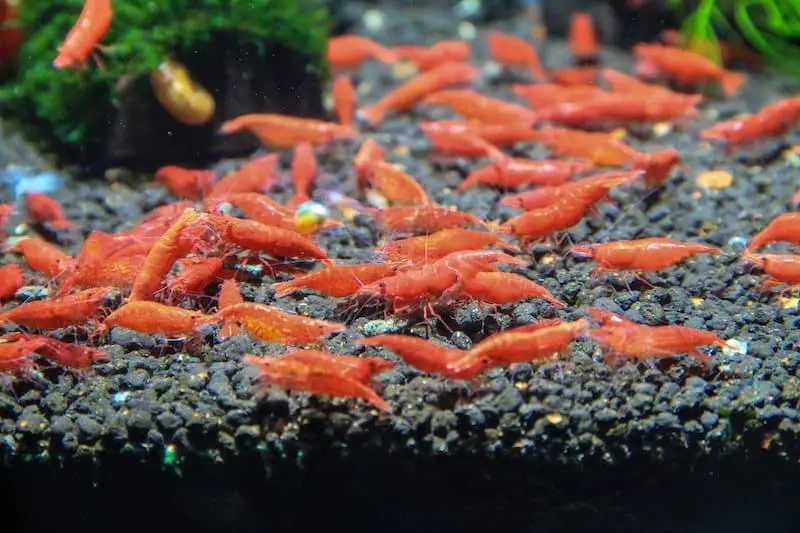
Contents
What Do Shrimp Need to Breed?
It’s not enough to create a survival environment for your shrimp.
Breeder-hopefuls looking for the proper shrimp breeding tank setup may also want to consider the minute details that can nudge breeding in the right direction, as it’s a possibility that shrimp may not end up breeding.
You’ll want to take these considerations into account to help increase the chances of your shrimp becoming pregnant, growing normally, and continuing to reproduce.
Basic considerations include:
Tank Size
Tank size depends on your preferences. Ten-gallon tanks are great for starters, but they can be a bit pricey, and you need some dedicated room to house them. You can use tanks as small as two or three gallons, too, with success.
There are a couple of schools of thought about shrimp breeding tank sizes.
On the one hand, if you’re worried about keeping the water parameters and temperature fluctuations in check, a smaller tank would probably be best. It doesn’t completely rule out these potentially deadly factors, but you may be less likely to experience them with small(ish) tanks.
However, some shrimp breeders believe that larger tanks give shrimp more room to roam (and breed) as well as more water to dilute a chemistry mishap.
Ultimately, it depends on your shrimp species and what you feel comfortable with using. Some breeders successfully breed smaller shrimp varieties in tanks less than 5 gallons large. While others swear by a 10-gallon minimum.
For my complete guide on how to choosing the right tank size for breeding shrimp, click here.
Filter Setup
It may relieve you (and your wallet) to know that simple is best when it comes to a shrimp breeding tank setup. You may be tempted to sink money into fancier filtration setups, but they don’t necessarily keep the shrimp happier or the water conditions any safer than inexpensive ones.
The primary functions of a filter are:
- The provision of good bacteria
- To cycle nitrogen and filter waste
- The creation of necessary water flow
Three main types of filters work well with a shrimp breeding tank setup:
Sponge Filters
Sponge filters are the darling of both beginner and veteran shrimp breeders alike because of their efficiency and inexpensive price tag. It does exactly what it’s supposed to do. It provides gentle water flow for a shrimp colony without the potential danger of baby shrimp getting sucked into the filter.
They’re also great at maintaining a high level of beneficial bacteria in a tank and are easy to maintain. The downside is that chemical filtration is up to you because they generally don’t have an extra chamber to take care of it automatically.
Hang on Back (HOB) Filters
Hang-on-Back or HOB filters are preferred by breeders who don’t want their filter setup to get in the way of their hardscape aesthetics. They’re also readily available at most aquatic stores.
However, there is a potential for shrimp to get sucked into the intake tube. If you decide that a HOB is a way to go, remember to use an intake sponge to minimize this potential hazard for your colony.
Both beginners and veteran breeders like the hands-off approach to filtration with this setup. It combines all the necessary filtration like biological and chemical in one device. They also come at a decent price range fit for most budgets.
The downside of using HOB filters includes noise, maintenance, power dependency, and potential leaks. It also doesn’t provide a surface area to grow beneficial bacteria the way that sponge filters do.
Canister Filters
Canister filters are in the premium category for a shrimp breeding tanks setup. They provide all the necessary filtrations to ensure a clean tank.
Canister filters are also very reliable, with one of the best flow rates for the tank. In addition, they’re generally discreet and virtually noiseless when you plug them in.
As a bonus, they also provide a large surface area to ensure healthy bacteria growth.
This premium setup comes with a premium price tag, though.
Canister filter replacements may be very pricey for breeders on a budget, and the maintenance can be very time-consuming.
Water Conditions
The most crucial aspect of your shrimp breeding tank setup will be monitoring your water parameters. Unfortunately, there are no general guidelines in this area since different species have different water requirements.
For example, Caridina Catonensis or ‘The Delicate Flowers’ depend on a pH range of 5.8 to 6.8 with 4-6 dGH and 0-1 dKH. Caridina Serrata or ‘The Tranquil Tigers’ variety, on the other hand, needs a pH range of 6.0 to 7.0 with 3-8 dGH and 1-4 dKH.
Before you buy the components for your setup, you need to research the type of shrimp you plan on breeding. Different varieties have different requirements.
If you plan to use Reverse-Osmosis or RODI water for Cardinia shrimp types, you can use water remineralizers to achieve the necessary water chemistry for them to thrive. You can use tap water with a dechlorinator, though, for many neocardina types.
Temperature
Like your tank’s water parameters, the optimal temperature for your tank depends on the type of shrimp you keep in it. For example, Neocardina davidi or the ‘Hardy Heroes’ can handle warmer waters. The average temperature for this breed is around 65-82° Fahrenheit, with a higher range between 80-82°.
However, the more fragile Cardinia cantonesis or the ‘Delicate Flower’ prefer slightly cooler temperatures ranging from 68-78° Fahrenheit.
There are a variety of studies online about the effects of temperature on breeding shrimp. Higher ranged temperatures tend to speed up the breeding process, but they can also shorten the shrimp’s overall lifespan.
On the other side of the coin, cooler water temperatures can lengthen a shrimp’s lifespan while lengthening breeding and breeding cycles in turn.
When in doubt, it may be best to choose the middle ground of the recommended temperature range for your shrimp type and don’t forget to consider where you got it. Shrimp like consistency, and that includes water chemistry as well as temperature.
Nest Materials
Every shrimp breeding tank setup should include materials for nesting and hiding. The actual materials may vary depending on what’s available and the type of shrimp you intended to breed.
Woods
You can use driftwood like Malaysian driftwood, Cholla wood, Spider wood, and Mopani wood. Like the Malaysian variety, driftwood sinks to the bottom of the tank and provides various places for shrimp to hide and graze.
Just make sure to clean and cure the driftwood properly before introducing it into your shrimp tank environment and be vigilant about watching for signs of decay or excessive biofilm growth.
Stones
Lava rocks and Ohko stones are also excellent materials for nesting and hiding. They’re also usually available in smaller pieces so that you can create your own aquascapes and caves for the shrimp.
Moss and Aquatic Plants
You can never have enough moss and aquatic plants in a shrimp breeding tank setup. They’re a great source of nourishment for these little critters, and they also have the added effect of filtering out nitrate and ammonia.
Check out undemanding plants like anubias, ferns, and bucephalandra when planning your tank setup. Not only do they help grow algae and biofilm, but they may also be attached to wood or wedged into rook nooks for added effect.
Leaf Litter
Leaf litter like moringa, walnut, and Indian almond leaves can help re-create a shrimp colony’s natural environment. Shrimp like to munch on the leaves and provide an excellent surface area for biofilm. In addition, many leaves like the ones listed provide antifungal properties to help ensure a healthy tank environment.
Leaf litter may be bought from a store or sourced in nature. Whichever method you choose, make sure that the leaves are chemical- and pesticide-free before putting them in the tank.
Some breeders like to pre-soak leaf litter in aquarium water before putting them into the breeding tank to remove tannins and start the micro-organism growth process.
Look for Quality Stock
Bargain shopping has its place, but not when you’re sourcing stock for your new shrimp breeding tank setup. When you buy from well-reviewed websites or local breeders, you’re ensuring that your new shrimp are the best quality and come without diseases like Vorticella and Ellobiopsidae.
Quality sources are also more open to answering questions about caring for a particular breed and recommended water parameters for the tank.
In Summary
Hopefully this article gave you a good overview of everything you need to set up your shrimp breeding tank. This is a great guide to refer back to for your hobby tank or if you’re breeding shrimp to sell as a side hustle.
As you can see, there are a lot of factors to consider, so be sure to bookmark this page!
